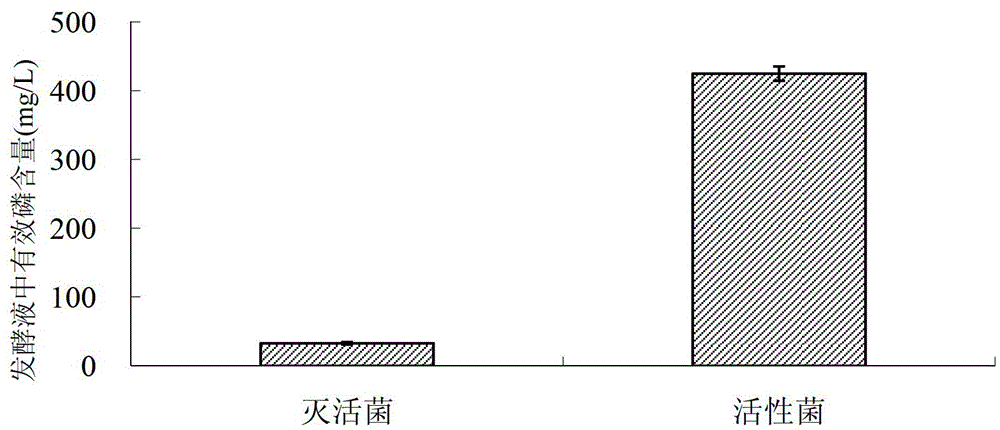Plant growth-promoting rhizobacteria and application thereof
A technology for plant roots and growth-promoting bacteria, applied in plant growth regulators, plant growth regulators, applications, etc., can solve problems such as soil environment that may not be suitable for fluvo-aquic soil, achieve good growth-promoting effects, improve utilization, increase Effects of Phosphorus Content in Plants
- Summary
- Abstract
- Description
- Claims
- Application Information
AI Technical Summary
Problems solved by technology
Method used
Image
Examples
Embodiment 1
[0033] First prepare the following media.
[0034] LB medium: peptone 10g, yeast extract 5g, sodium chloride 10g, agar 20g, distilled water 1000ml, pH7.0-7.2, sterilized at 121°C for 20min.
[0035] LB liquid medium: without agar, other conditions are the same as above.
[0036] Inorganic phosphorus bacteria medium (PKO medium): 5g tricalcium phosphate, 10g glucose, 0.5g ammonium sulfate, 0.3g sodium chloride, 0.3g magnesium sulfate heptahydrate, 0.3g potassium chloride, 0.03g manganese sulfate, heptahydrate Ferrous sulfate 0.03g, pH7.0 agar 20g, distilled water 1000ml, pH7.0~7.2, sterilized at 121°C for 20min.
[0037] Weigh 10g of the plant rhizosphere fluvo-aquic soil collected from Banqiao, Nanjing, and put it in a 250ml Erlenmeyer flask filled with 100ml of sterilized water. In a shaker, shake at 30°C and 150r / min for 20min. Set aside for 10 minutes to obtain a soil suspension. The soil suspension contains several kinds of growth-promoting bacteria, which are diluted b...
Embodiment 2
[0045] Aerobic test
[0046] Pour the sterilized LB culture medium into 3 sterilized test tubes, at about 2 / 3, on the aseptic operating table, use an inoculation needle to pick up the bacteria cultured on the slant, puncture and inoculate into the above culture base (must pierce to the bottom of the tube). Cultivate at 30°C, and observe the results in 3 days to 7 days respectively. Those that grow on the surface of the agar column are aerobic bacteria, and those that grow along the puncture line are anaerobic or facultative anaerobic bacteria.
[0047] The test results of plant rhizosphere growth-promoting bacteria Y1 (CGMCC No.7130) showed that colonies grew along the surface of the agar column, and no colonies grew in the puncture line, which was strictly aerobic.
[0048] Determination of catalase
[0049] Put 1 drop of 3% H on a clean slide 2 o 2 , take 1 ring of 18-24h LB slant culture, in H 2 o 2 Smear in the middle, if bubbles are produced, it is positive, otherw...
Embodiment 3
[0076] In order to further verify the ability and optimum conditions of the rhizosphere growth-promoting bacteria Y1 (CGMCC No.7130) obtained in Example 1 to decompose phosphorus, the effect of phosphorus solubilization on different pH, different liquid volumes, different carbon sources, and different nitrogen sources is as follows Impact.
[0077] Adjust the inorganic phosphorus bacteria medium (PKO medium) to different pH (4, 5, 6, 7, 8, 9, 10), take 50mL and put it in a 250mL Erlenmeyer flask, press 1% (v / v ) inoculum amount to inoculate the Y1 bacteria in the logarithmic growth phase, place it at 30°C, and culture it on a shaker at 180r / min for 96 hours, and measure the phosphorus-dissolving effect of the Y1 bacteria according to the method of quantitative determination. The results are as follows: figure 2 As shown, it shows that Y1 (CGMCC No.7130) has a poor phosphorus-solubilizing effect when the pH is 9 and 10. In a strong alkaline environment, the bacteria cannot gro...
PUM
 Login to View More
Login to View More Abstract
Description
Claims
Application Information
 Login to View More
Login to View More - R&D
- Intellectual Property
- Life Sciences
- Materials
- Tech Scout
- Unparalleled Data Quality
- Higher Quality Content
- 60% Fewer Hallucinations
Browse by: Latest US Patents, China's latest patents, Technical Efficacy Thesaurus, Application Domain, Technology Topic, Popular Technical Reports.
© 2025 PatSnap. All rights reserved.Legal|Privacy policy|Modern Slavery Act Transparency Statement|Sitemap|About US| Contact US: help@patsnap.com



